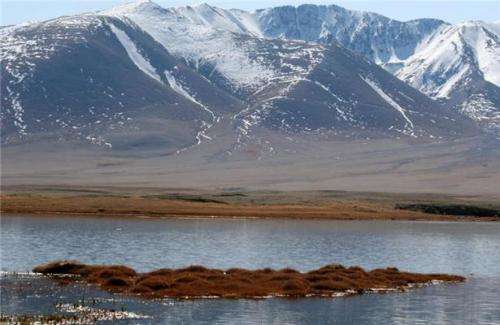On the trail of Mongolian steppe lakes

To catalogue more than 12,000 lakes and lagoons in Mongolia's steppe, to identify new Entomostraca species and to develop strategies to diagnose the state of lakes in the Iberian Peninsula and Europe are the main scientific challenges faced by the Limnological Catalogue of Mongolian Lakes, a project led by researcher Miquel Alonso, who collaborates with the Department of Ecology of the University of Barcelona and studies the limnology of lakes.
Mongolia is a vast Central Asian country with the world's most extreme continental climate and notable aridity. Nevertheless, it has a great abundance and variety of lakes and a considerable network of fast-flowing rivers. Human intervention is barely detectable, both due to the scant population and its traditional occupations; this has preserved Mongolian lakes and rivers in a pristine condition up to our times. Its geographic position, opposed to the Iberian Peninsula, enables to establish taxonomic relationships between the existing fauna of the longitudinal extremes of the Palearctic.
From Mongolia to the Iberian Peninsula
Steppe lakes can be found in plains in regions with a continental climate at different latitudes all over the planet. These lakes are shallow and very fragile; they dry up easily and their biological productivity is high. "Steppe lakes are extraordinarily valuable ecosystems", ensures Miguel Alonso, member of the Research Group on Freshwater Ecology and Management (FEM) of UB. "In Mongolia there are exceptionally preserved lagoons that are similar to the ones that existed in the Iberian Peninsula which disappeared due to human action", adds the expert.
Large permanent freshwater lakes, temporal lagoons with highly mineralized waters and hypersaline lakes are some of the ecosystems which have been studied since 2005 in Mongolia by the expeditions led by Miguel Alonso. To date, the project has enabled to study the ecological characteristics of 880 steppe lakes in Mongolia, within the Program for the Conservation of Biodiversity promoted by ENDESA; the National University of Mongolia collaborates in the project too.
In search of authentic steppes
"Authentic steppes are in Central Asia", explains Alonso. "Unlike Spain, Mongolia's summer is hot and wet, whereas cold and drought happen in winter; these are the characteristics of an authentic steppe". Nevertheless, Asian steppe lakes are very similar to the ones in the Peninsula, with Mediterranean climate; they share many similarities regarding hydromorphology and biological communities.
"The research —continues Alonso— enables us to establish comparisons and biogeographic relationships among vicarious species of Iberian steppe lakes, which have either disappeared entirely or are seriously damaged today. The project will also contribute to establish indicators of reference ecological status for steppe lakes in industrialized Europe as current European regulations state".
More species on Central Asia biodiversity map
Galaziella murae, Alona irinae, Alona floessneri and Phallocryptus tserensodnomi are the new crustacean species discovered which enlarge the biodiversity map of Mongolian lake ecosystems. They are brachiopod crustaceans, a very ancient group of crustaceans, considered authentic alive fossils. According to results, P. tserensodnomi is very similar to P. spinosa, a species from occidental Palaearctic region. In the case of A. floessneri, the species is quite similar to Alona salina —a species identified in 1996 in Spain by Alonso—, which can be found in Bodón Blanco lakes (Bocigas, Valladolid) and other endorheic lagoons in the Iberian Peninsula and Iran.
According to Alonso, who has described twenty biological species throughout his research career, "crustaceans are studied as bioindicators because they are highly-specialised organisms, their life cycle is relatively long and they leave permanent biological traces which are easily to recognise and very interesting to perform paleoclimate reconstructions".
Steppe lakes: an alarming scene in the Iberian Peninsula
Mining aquifer overexploitation and some projects of water conveyance are the most direct threats to the conservation of these ecosystems in the Mongol country. In the case of the Iberian Peninsula, the situation of steppe lakes is particularly alarming. Miguel Alonso, who got his PhD from UB under the supervision of the prestigious ecologist Ramon Margalef, states: "In our country, there are unique steppes in Occidental Europe, for instance the Monegros, the Ebro basin, the Duero basin, Tajo-Gualdquivir, la Mancha, etc. However, some many emblematic lagoons have disappeared for the last years in these areas due to human action. Agriculture is the main threat to these ecosystems but there are still possibilities to recover some of them; it is not a difficult task. We need to be intelligent and have the willpower to preserve them."
More information: "A new fairy shrimp Phallocryptus tserensodnomi (Branchiopoda: Anostraca) from Mongolia." MIGUEL ALONSO, MARC VENTURA. ZOOTAXA, DOI: dx.doi.org/10.11646/zootaxa.3670.3.5
"New species of Alona from South-East Russia and Mongolia related to Alonasalina." Alonso, 1996 (Cladocera: Anomopoda: Chydoridae) ARTEM SINEV, MIGUEL ALONSO, NATALIA G. SHEVELEVA. ZOOTAXA. Zootaxa 2326: 1–23 (2009)
"A new fairy shrimp Galaziella murae (Branchiopoda: Anostraca) from Mongolia." MIGUEL ALONSO, HIDETOSHI NAGANAWA. Journal of Biological Research-Thessaloniki 10: 119 – 128, 2008
"Branchiopoda and Copepoda (Crustacea) in Mongolian Saline Lakes." Miguel Alonso. Mongolian Journal of Biological Sciences 2010 Vol. 8(1): 9-16
Journal information: Zootaxa
Provided by University of Barcelona
















